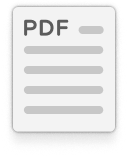At a time when online productivity tools such as Google Docs dominate collaborative work environments, one might think that PDF (Portable Document Format) is a thing of the past. However, despite the rise of the cloud and real-time editing, PDF remains indispensable in many contexts. Why is this format so resistant to digital evolution? In what cases is it still essential? Let's compare the two tools and examine the situations where PDF retains a clear advantage.
1. Control over layout
Advantage PDF
PDF freezes the document in a universal and stable format: what you see on the screen is exactly what will be printed or shared, with no layout shifts. Whether on Mac, Windows, or mobile, the rendering is identical.
Google Docs, although excellent for collaboration, sometimes suffers from display or compatibility issues when printing or downloading (e.g. in .docx or .pdf), especially when it comes to complex documents with tables, columns or specific fonts.
PDF remains essential for:
- Professional CVs
- Legal documents
- Sales brochures
- Files intended for printing (flyers, posters)
2. Electronic signatures and legal documents
Advantage of PDF
The PDF format supports certified electronic signatures, which are often required for contracts, official agreements or administrative documents. Tools such as PDFSmart allow you to add signatures that comply with legal standards (eIDAS in Europe, for example).
Google Docs does allow you to annotate or add a signature image, but this is neither secure nor legally valid without additional processing.
PDF is essential for:
- Employment contracts
- Purchase orders
- Invoices
- Tax or notarised documents
3. Archiving and long-term compatibility
Advantage of PDF
PDF is an international standard (ISO 32000). It is designed for long-term digital archiving, particularly through its PDF/A sub-format, which is used by government agencies, libraries and institutions.
Google Docs depends on a proprietary ecosystem (Google Workspace) and the cloud. Without a connection, or if the service changes or disappears, documents may become inaccessible or incompatible.
PDF is essential for:
- Official archives
- Medical records
- University dissertations or theses
- Long-term backups
4. Data protection and confidentiality
Advantage of PDF
A PDF file can be password-protected, encrypted or restricted (read-only, no copying or printing). This makes it an ideal format for transmitting sensitive data.
Google Docs also offers sharing options, but the files remain hosted in Google's cloud, which sometimes raises questions about data privacy or sovereignty (particularly in businesses or public administrations).
PDF remains indispensable for:
- Confidential HR files
- Bank documents
- Sensitive internal presentations
- Secure sending
5. Offline universality
Advantage of PDF
A PDF can be read without an Internet connection on almost any device, thanks to native or free readers. It does not depend on any platform.
Google Docs requires at least prior synchronisation with Google Drive, and offline access remains limited and sometimes unstable.
PDF is essential for:
- Offline presentations (conferences, travel)
- Documents distributed on USB sticks
- Printable course materials
In summary, Google Docs is a good tool for quick creation, editing and collaboration, while PDF remains the gold standard for formal presentation, security, archiving and universal compatibility.
However, modern platforms such as PDFSmart show that PDF is no longer reserved for fixed or unilateral use. With its many online tools, PDFSmart allows you to edit, merge, sign, convert or compress PDF files directly in your browser. Better still, it offers practical features for collaborating between teams, sharing by email or managing professional documents without installing any software.
As a result, PDF is not only a stable and secure format, but also an agile medium that is well suited to the modern requirements of collaborative work.






